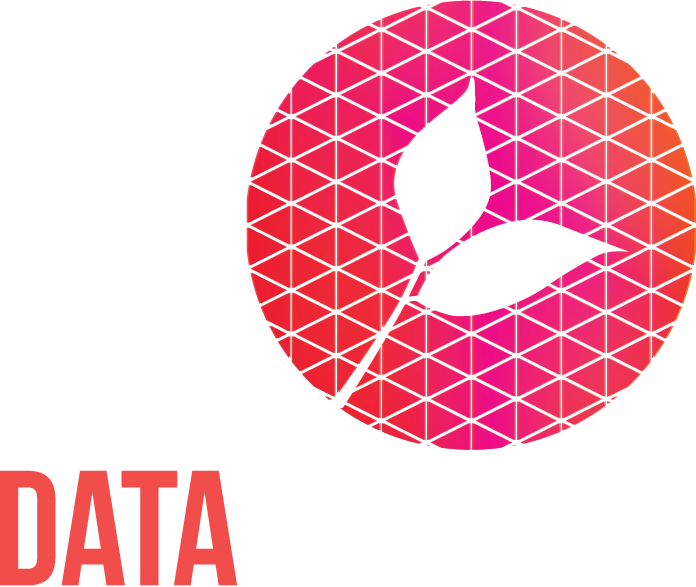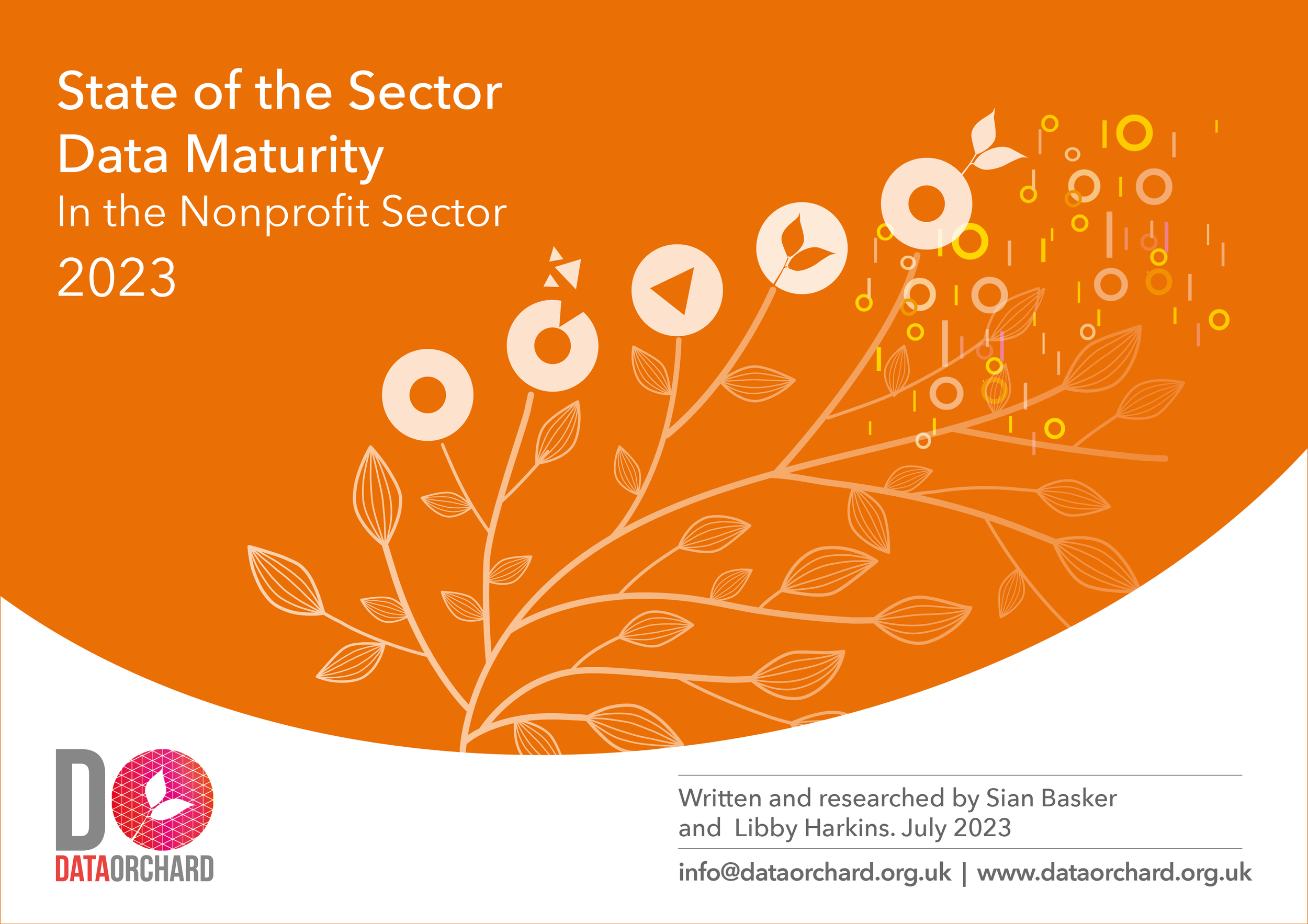State of the Sector: Data Maturity in the Nonprofit Sector 2023
With over 6,000 people now having completed our data maturity assessment, and three years of data measuring and benchmarking how organisations are doing, we’re excited to be able to share some unique insights in our latest report into data maturity in the nonprofit sector.
In this report we analyse the most recent data from 2022-23, but also, for the first time take a long-lens look at what the data over the last three years tells us about what’s changing for people and organisations in the sector.
Read the executive summary below, or download the full report as a pdf.
State of the Sector: Data Maturity in the Nonprofit Sector 2023
Written and researched by Sian Basker and Libby Harkins, July 2023
Executive Summary
Data maturity is an organisation’s journey towards improvement and increased capability in using data. Data Orchard created a framework model which describes data maturity on a five-stage journey. This progresses from ‘Unaware’ through to ‘Mastering’ across seven key themes: Uses, Data, Analysis, Leadership, Culture, Tools, and Skills.
In October 2019 we launched an online Data Maturity Assessment tool which enables organisations to measure where they are on the five-stage journey to data maturity. There is a free version for individual users, an organisation version for multiple users, and a cohort version for multiple organisations.
About the data
Data Orchard’s Data Maturity Assessment tool has been used by thousands of people from all kinds of organisations and sectors, and from all over the world. This report focuses on those that have used the tool in the 2022-23 financial year and takes a longer-lens look using three years of user data between 2020 and 2023.
Whilst commercial organisations are included for sector comparisons, this report primarily presents findings on data from validated nonprofit (non-commercial) organisations. These include: non-governmental organisations (NGOs) like charities and social enterprises, public sector organisations, and universities.
Key insights
Profile of data maturity by sector and type of organisation
Perhaps surprisingly, we didn’t find much difference in data maturity between sectors. Our research shows the public sector slightly ahead, followed by the commercial sector and then NGOs but overall they are very similar. In every sector there are organisations at different stages with some leading the way and others lagging behind.
The size of an organisation, by annual income or number of employees, doesn’t have any effect on data maturity. However, it’s possible the type of activity/subsector and the geographic location of an organisation may have an influence.
How things are changing
In the nonprofit sector there has been a shift over the last three years, with increasing numbers of organisations in the ‘Developing’ and ‘Mastering’ stages. In 2022-23 44% were in these two higher stages compared with 29% in 2020-21. The biggest advances have been in areas of Culture, Tools and Uses. Average scores for Leadership, Skills and Analysis have barely changed, and scores for Data have become a little worse.
What’s improving?
CULTURE: The sector is doing well in relation to openness. More than two-thirds of organisations share data externally with partners, networks, and stakeholders. Half openly publish their own data and analysis and/or share data with their clients/service users. For 60% polices and practices around security and protection fairly strong. However scores around ‘self-questioning’ and ‘team approach’ remain more mixed.
TOOLS: The tools theme has shifted from the 4th highest scoring theme amongst nonprofits to the 2nd highest in 3 years. This may be related to digital transformation/ investment initiatives, much accelerated during and since the pandemic. There’s more digital data (and less on paper) and more use of digital tools for collecting and storing data (including one in ten using mobile apps). Business intelligence/dashboards and data visualisation are on the increase and around 1 in 3 organisations use these moderately or extensively. Around 15% are making use of advanced analytics tools (e.g. coding, mapping). Around a quarter say they have good tools for joining and relating data from different sources.
USES: With more organisations in the advanced ‘Developing’ and ‘Mastering’ stages, rewards and benefits of data and analytics are being seen more widely. In relation to services, data is improving the ability of organisations to evidence impact and needs, target and communicate with clients, and design and deliver better services and products. Internally, organisations are benefiting from increased levels of knowledge and expertise, better strategic planning and decision making, and improved impact. Many are also seeing increased income and efficiency savings.
What’s getting worse?
Exploring patterns over time suggest some measures of data maturity are getting worse.
Fewer say they have good quality data. 57% tended to disagree that their data is complete, accurate and kept up to date in 2022-23, compared with 44% in 2020-21.
More organisations say their staff are not data literate. 58% tended to disagree that staff were data literate in 2022-23, compared with 47% in 2020-21.
There’s less confidence about data security. 51% tended to agree they were confident about the security of the data they held in 2022-23, compared with 61% in 2020-21.
It’s possible these lower scores relate to an increase in awareness about the importance of these issues in organisations.
What’s happening in leadership?
Leaders are key to planning, decision-making and resourcing data maturity (and the second largest user group of the assessment tool by role type). Overall scores for Leadership haven't shifted much in the last three years, though there are indications things are starting to change in some areas. More respondents say: that their organisation has an overarching business plan with defined measurable goals; they have data and analytics expertise amongst their leadership; and leaders who are actively harnessing the value from their data. This research also shows data maturity is strongly related to leadership investment in people, skills, learning and tools.
Where are the greatest weaknesses?
Skills and Analysis are consistently the weakest of the seven key themes, with little change in the scores over the last three years.
Fewer than one in five say they have appropriate numbers of staff managing and developing their data capabilities.
Fewer than a quarter say they have the right skills and capabilities to maximise the use of their data.
Fewer than half say they analyse data in useful and meaningful ways. Most are doing simple descriptive analysis of past data, rather than deeper exploratory, experimental, or predictive analysis.
Much reporting and analysis at a strategic level is manually collated from multiple sources. Just over a third have semi-automated reporting and fewer than 4% fully automated.
The elephant in the room
Some aspects of data and data management have growing environmental, legal, and resource-waste implications, yet are often overlooked in data strategies. As volumes of digital data in ‘cloud’ based systems continue to grow at high speed, the environmental impact of data centres cannot be ignored. Just 36% say their digital files and documents are well organised and managed. And although paper-based data collection (and storage) has rapidly reduced in the last three years, 31% say they still use paper questionnaires and forms moderately or extensively.
Only 40% say they delete data about identifiable individuals that is no longer necessary (despite this being one of the key principles of the 2018 Data Protection Act). So it appears the tail-end of the data life cycle receives relatively little attention.
Salaries are usually among the highest areas of expenditure for nonprofits. Organisations in this research say more than half their staff’s time is spent working with data. Only a quarter of organisations say data is easily available and accessible to staff when they need it. Whilst there is much to be gained from technical efficiencies like reproducible analytics pipelines and interactive dashboards, it seems there is also much to be gained from good data management, governance, and housekeeping.
Reflections
Our research shows that the nonprofit sector is progressing in its data maturity. Those that are investing the extra effort and resources are reaping rich rewards for their organisations and those they serve.
Many still have a long way to travel on their data maturity journeys and there’s a clear need for improved skills and support. This is especially so for leadership teams, who are facing many new responsibilities that come alongside exciting opportunities.
We hope this research will stimulate policy makers and funders to channel resources into advancing data maturity. You can find out more about our data maturity assessments for organisations, cohorts and partners here.


